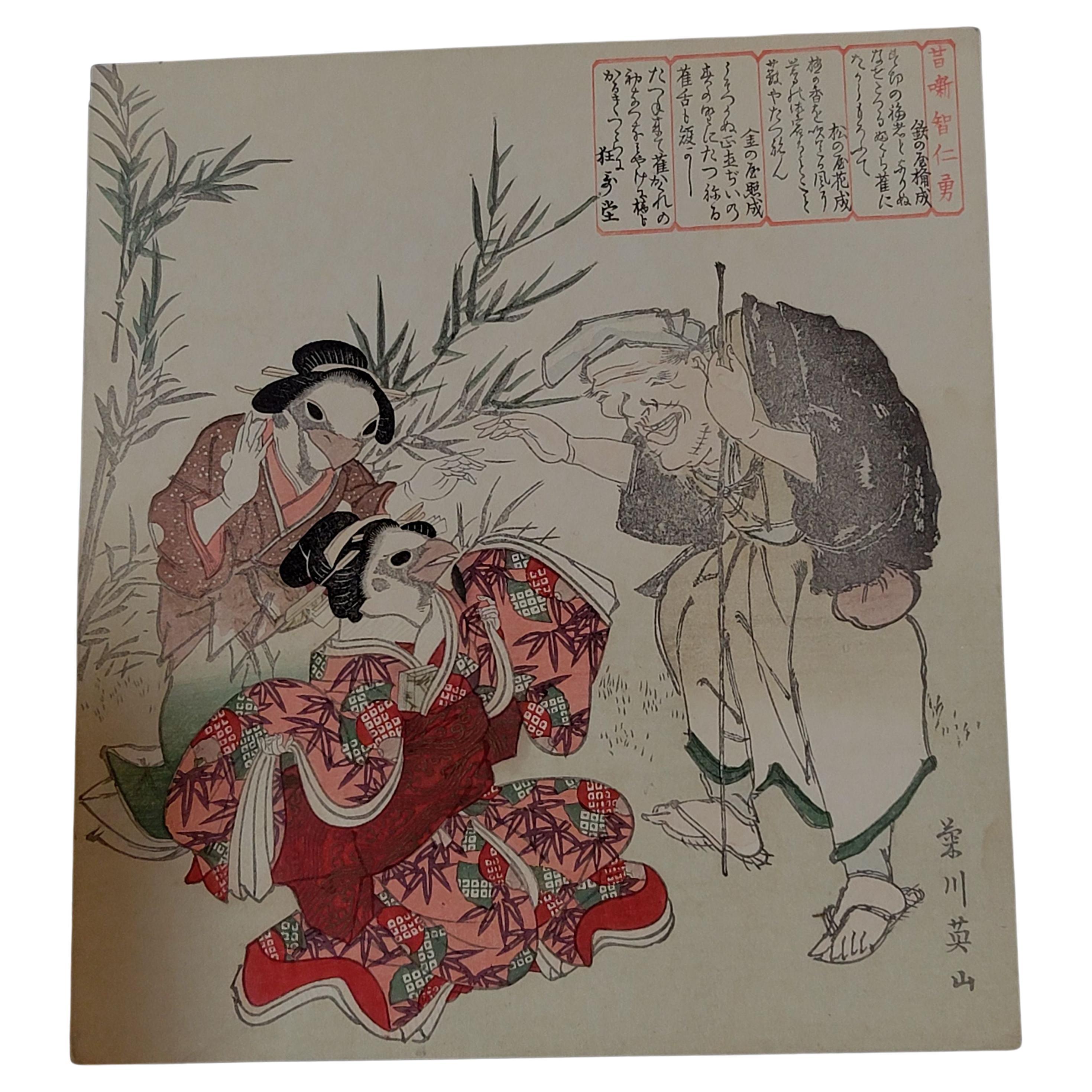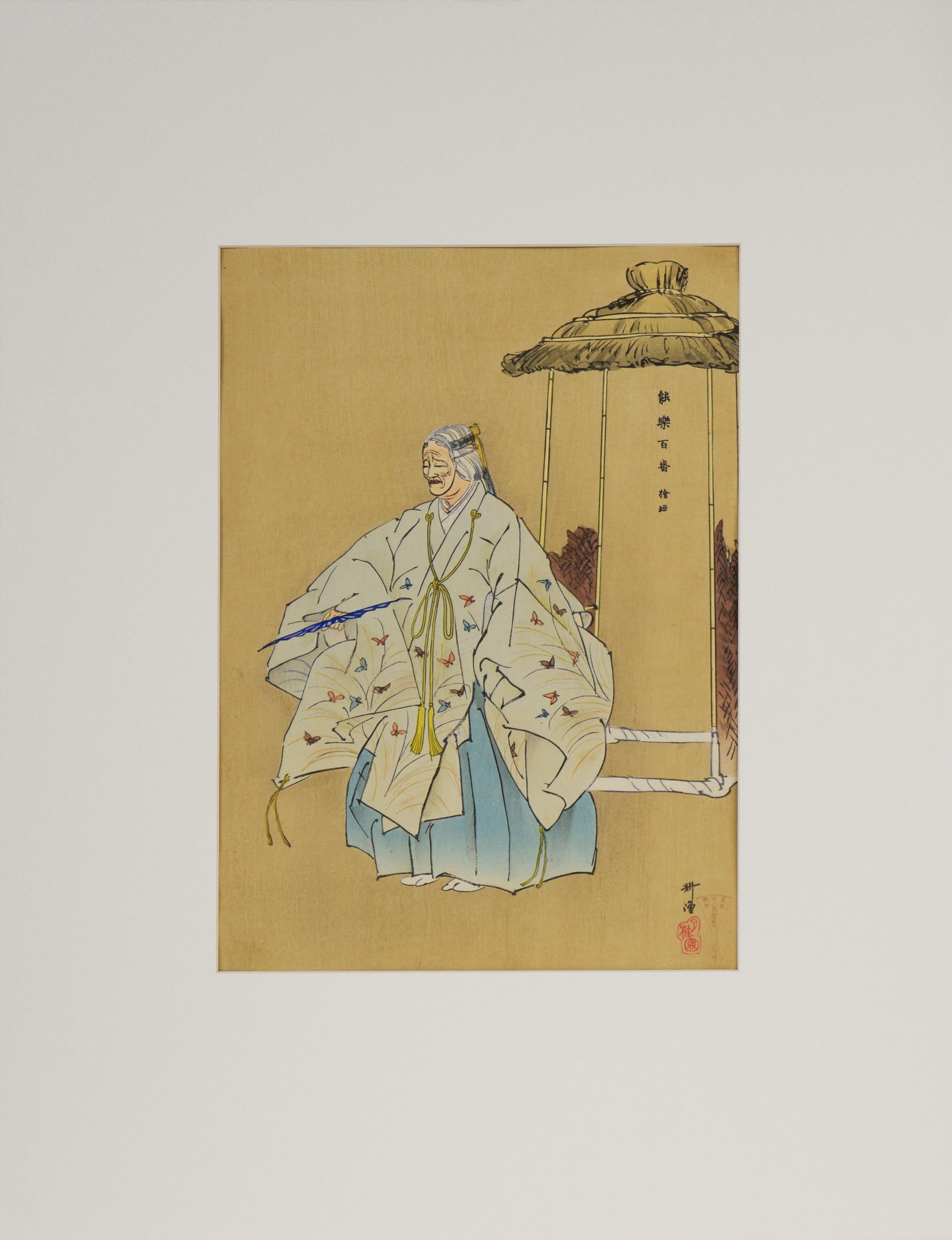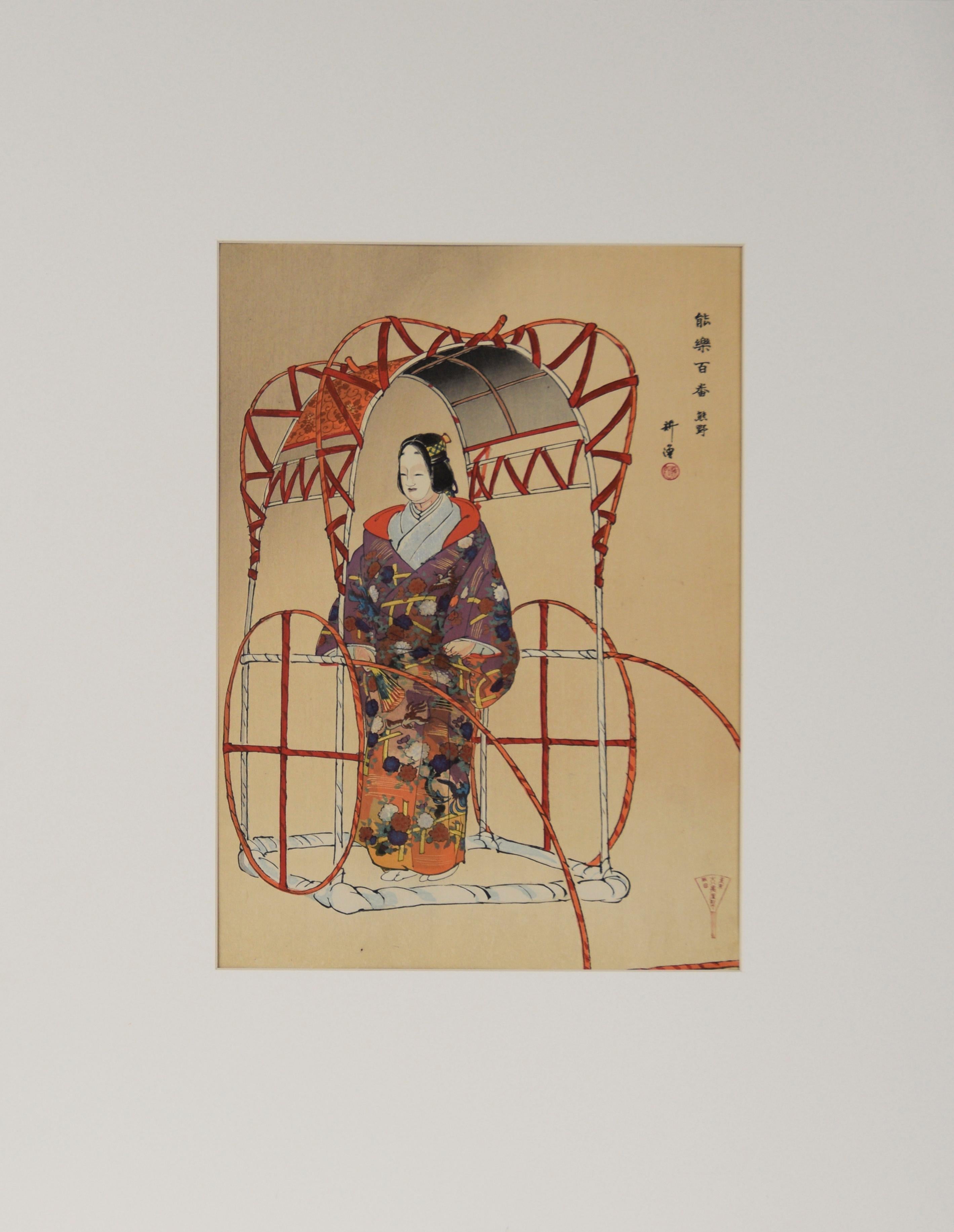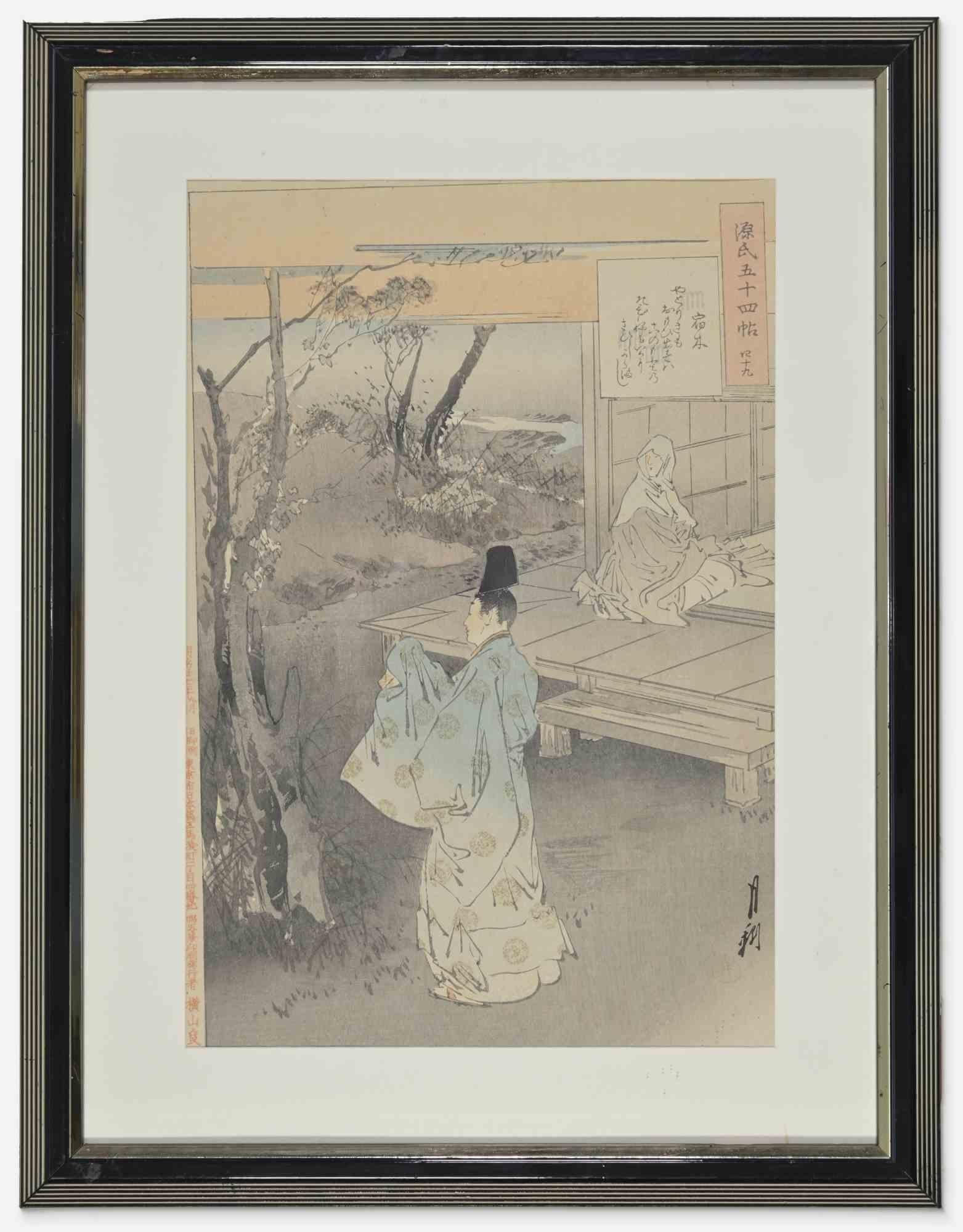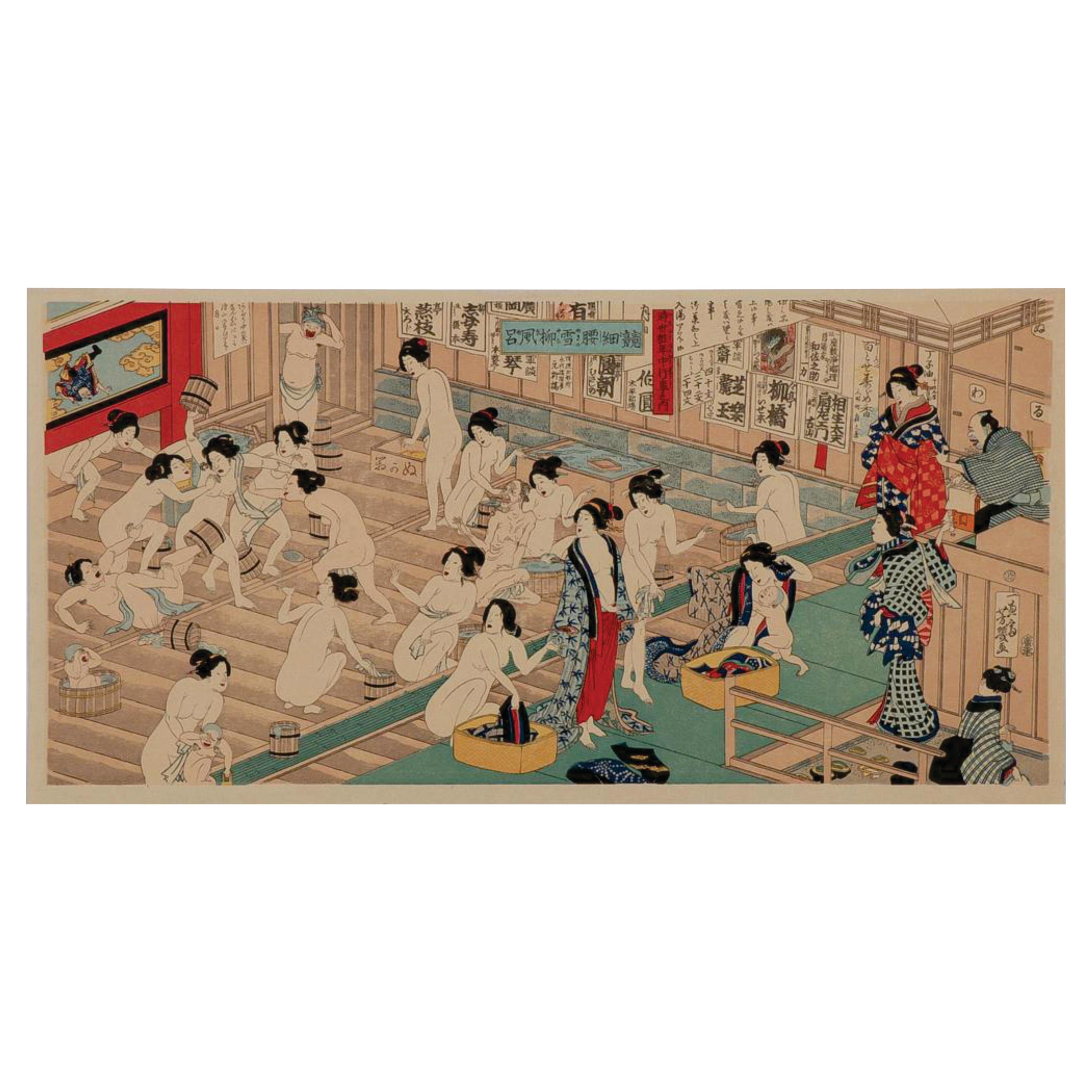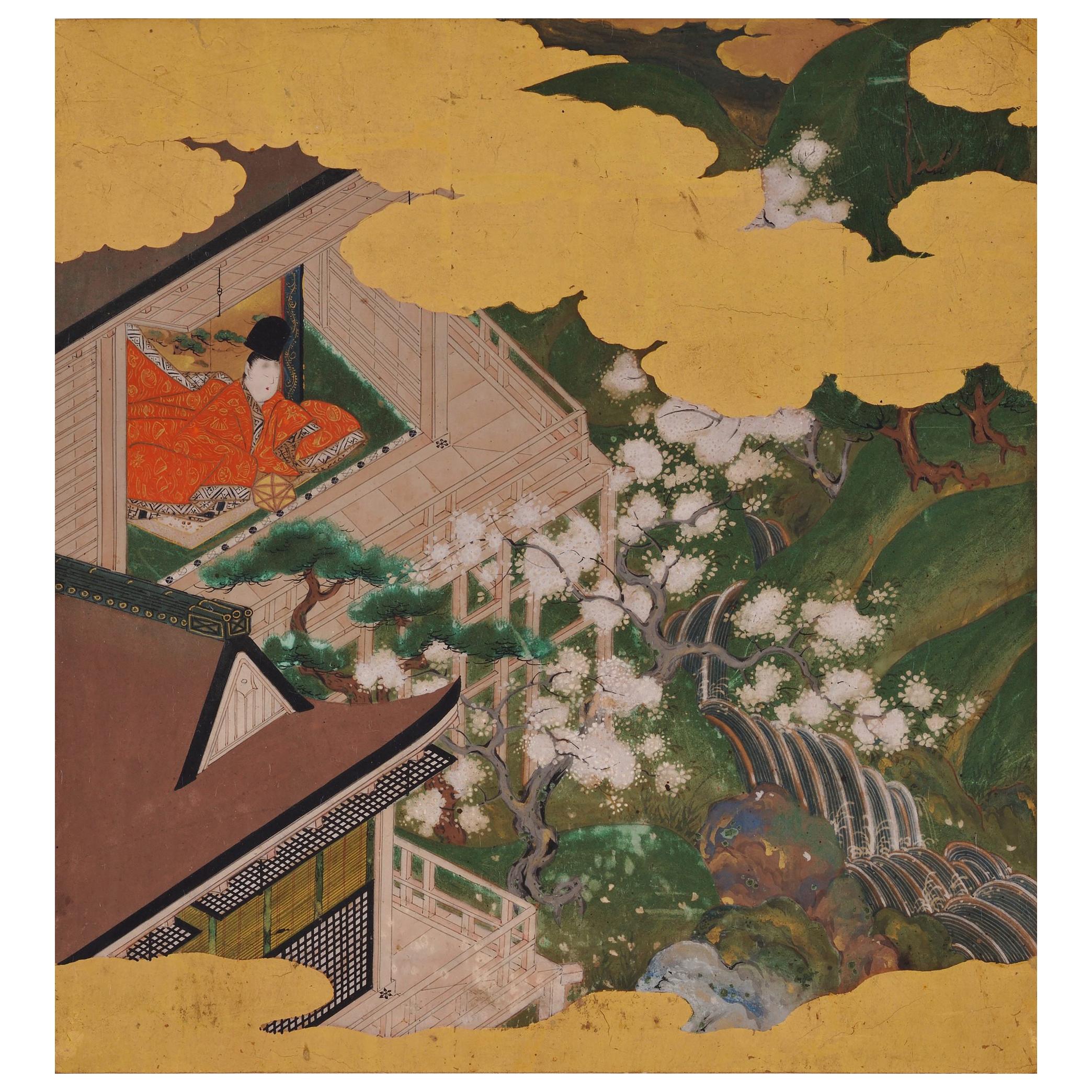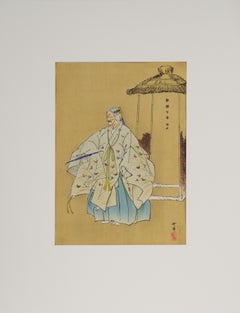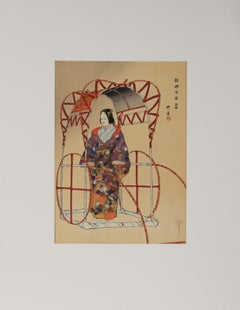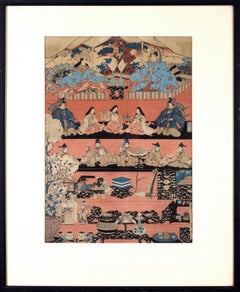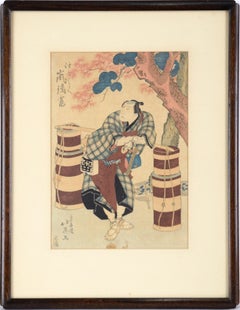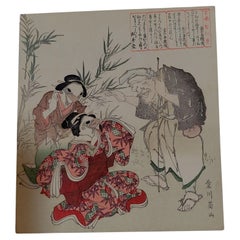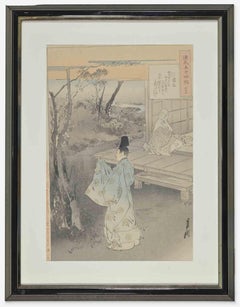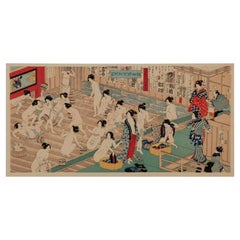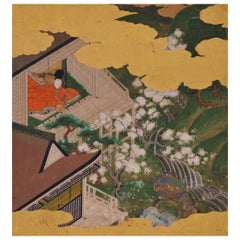Items Similar to Japanese Artisans - Silk Dying -Japanese Woodblock Print
Want more images or videos?
Request additional images or videos from the seller
1 of 10
Tosa MitsuyoshiJapanese Artisans - Silk Dying -Japanese Woodblock PrintCirca 1920s
Circa 1920s
$1,550
£1,165.93
€1,343.92
CA$2,183.35
A$2,395.65
CHF 1,253.77
MX$29,482.35
NOK 15,795.65
SEK 14,794.98
DKK 10,034.94
About the Item
Japanese Artisans - Japanese Woodblock Print J
Japanese woodblock depicting six women, all wearing vibrant kimonos, working on crafts by Tosa Mitsuoki (Japanese, 1617-1691). Japanese,c. 1600. Handcraft depiction (dye works).Section from a painted screen with presentations of handcraft.Kita-in, Saitama.
Stamped lower left.
Presented in a white mat and giltwood frame.
Frame: 19"H x 14"W
Mat: 18.25"H x 13.25"W
Image: 14.5"H x 9.5"W
Tosa Mitsuoki was a Japanese painter, reinvigorating the Yamato style of classical Japanese painting. Yamato-e originated from interest in reproducing early Tang dynasty paintings, and was later reinvented and further refined to fit Japanese cultural perceptions in the late Heian period. Yamato, sometimes referred to as wa or kazu had become synonymous with the Tosa-ha by the Muromachi period as a way for Japanese artist to distinguish their works from those of mainland Chinese paintings, kara-e. Yamato-e incorporated various visual and literary techniques for establishing narrative. Works were not always accompanied with text and may rely on heavily on period specific visual motifs, icons, and symbols to relay a story or theme. Tosa style by the time of Mitsuoki focused heavily on depicting themes of plants and nature, famous places, meisho, the four seasons, shik, bird-and-flower, kacho. Many of these popular symbols and icons from mimicking Chinese practices, treating the original Chinese masterwork as a sort of prototype to improve upon. Popular formats for Mitsuoki's pictures were wall scrolls kakemono, or handscrolls that would be read from right to left with the accompanied story, sliding doors fusuma and folding screen panels byobu that featured up to six panels. Mitsuoki's style incorporated the depth and calligraphy techniques of ink wash brushwork similar to Song dynasty and Yuan dynasty Chinese court paintings, used cartoon-like sketch linework, innovation of historical designs, and excellent execution of decorative elements.
- Creator:Tosa Mitsuyoshi
- Creation Year:Circa 1920s
- Dimensions:Height: 19 in (48.26 cm)Width: 14 in (35.56 cm)Depth: 0.5 in (1.27 cm)
- Medium:
- Movement & Style:
- Period:
- Condition:Good condition. Some normal age toning to paper.
- Gallery Location:Soquel, CA
- Reference Number:Seller: N76081stDibs: LU54213870612
About the Seller
5.0
Platinum Seller
Premium sellers with a 4.7+ rating and 24-hour response times
Established in 1986
1stDibs seller since 2014
2,991 sales on 1stDibs
Typical response time: <1 hour
- ShippingRetrieving quote...Shipping from: Soquel, CA
- Return Policy
Authenticity Guarantee
In the unlikely event there’s an issue with an item’s authenticity, contact us within 1 year for a full refund. DetailsMoney-Back Guarantee
If your item is not as described, is damaged in transit, or does not arrive, contact us within 7 days for a full refund. Details24-Hour Cancellation
You have a 24-hour grace period in which to reconsider your purchase, with no questions asked.Vetted Professional Sellers
Our world-class sellers must adhere to strict standards for service and quality, maintaining the integrity of our listings.Price-Match Guarantee
If you find that a seller listed the same item for a lower price elsewhere, we’ll match it.Trusted Global Delivery
Our best-in-class carrier network provides specialized shipping options worldwide, including custom delivery.More From This Seller
View AllOne Hundred Prints Of The Noh - 1925 Original Japanese Woodblock Print
Located in Soquel, CA
One Hundred Prints Of The Noh - 1925 Original Japanese Woodblock Print
Original Japanese woodblock print by Tsukioka Kogyo (Japanese, 1869...
Category
1920s Edo Figurative Prints
Materials
Ink, Rice Paper, Woodcut
"Pictures Of Noh" - 1922 Original Japanese Woodblock Print
Located in Soquel, CA
"Pictures Of Noh" - 1922 Original Japanese Woodblock Print
Original Japanese woodblock print by Tsukioka Kogyo (Japanese, 1869-1927...
Category
1920s Edo Figurative Prints
Materials
Ink, Rice Paper, Woodcut
$461 Sale Price
35% Off
"Various Himochi" Wagashi Festival Japanese Woodblock Print by Utagawa Toyokuni
By Utagawa Toyokuni
Located in Soquel, CA
"Various Himochi" Wagashi Festival Japanese Woodblock Print by Utagawa Toyokuni
Rare oversized early 19th century 5-tiered woodblock by Utagawa Ichiyosai Toyokuni, (Japan, 1769-1825), a Japanese lord and wife oversee a sekku festival of food, music, and dolls or toys. '"oshi" is the first day of “Mi (Snake)” in the third month of the lunar calendar. This day, known in modern Japan as the Girls' Festival, originated in China as a form of purification ceremony in which water and drinking peach blossom wine were used to drive away evil. Many kinds of hishi-mochi appear in this picture of hina ningyo (dolls associated with Hinamatsuri, or the Girl’s Day) from Omochae.
The custom of eating special dishes at events throughout the year and at milestones in people's lives has existed since ancient times. This paragraph specifically focuses on the annual event called sekku, and life events that involve eating sweets. Joshi is the first day of “Mi (Snake)” in the third month of the lunar calendar. This day, known in modern Japan as the Girls' Festival, originated in China as a form of purification ceremony in which water and drinking peach blossom wine were used to drive away evil. According to the Keiso saijiki, in ancient China, on the third day of the third lunar month, people ate “ryuzetsuhan,” which is the juice of gogyo (Jersey cudweed) mixed with rice flour and nectar. In Japan, there is a record in the Heian period history book Nihon Montoku tenno jitsuroku [839-5] that it was an annual event to make kusamochi using gogyo on the third day of the third month of the lunar calendar, which may have been influenced by Chinese customs.
The tradition of eating kusamochi on the third day of the third month of the lunar calendar continued after that. By the Edo period, however, hishimochi had come to be used as a sweet to serve on the third day of the third month. A picture of a hishimochi is included in the Morisada manko , which we mentioned in Part 1. According to it, hishimochi in the Edo period were often three layers of green-white-green instead of the now common red-white-green. However, it is possible to see from our collection that not all hishimochi were made in this way. Omochae published in 1857, is a good example. Omochae is a type of ukiyoe print...
Category
1820s Edo Figurative Prints
Materials
Ink, Rice Paper, Woodcut
Actor Arashi Rikan II as Aburaya Yohei - Figurative Woodblock Print on Paper
Located in Soquel, CA
Actor Arashi Rikan II as Aburaya Yohei - Figurative Woodblock Print on Paper
Woodblock print of kabuki actor by Shunbaisai Hokuei (Japanes...
Category
1830s Edo Figurative Prints
Materials
Paper, Ink, Woodcut
"Enshoku Sanju-roku Kasen" (Thirty-six Enchanting Flowers) Woodblock on paper
By Toyohara Kunichika
Located in Soquel, CA
"Enshoku Sanju-roku Kasen" (Thirty-six Enchanting Flowers) Woodblock on paper
Elegant woodblock print by Toyohara Kunuchika (Japanese, 1835-1900). Three women are in talking with each other inside, while a man waits outside holding a bag of some kind. The colors in this piece are rich and saturated, primarily blues, greens, and purple.
Mat size: 16"H x 20"W
Paper size: 14.75"H x 9.88"W
Born in 1835, Toyohara Kunichika grew up in the Kyobashi district of Edo in the midst of merchants and artisans. In 1848, at age 13, he was accepted as an apprentice into the studio of Utagawa Kunisada I...
Category
1880s Edo Figurative Prints
Materials
Ink, Rice Paper, Woodcut
"Thirsty: the appearance of a town geisha in the Ansei era" - Woodblock on Paper
By Tsukioka Yoshitoshi
Located in Soquel, CA
"Thirsty: the appearance of a town geisha in the Ansei era" - Woodblock on Paper
From the series "Thirty-two Aspects of Customs and Manners" (Fuzoku sanjuniso)
Lively woodblock of a...
Category
1880s Edo Figurative Prints
Materials
Paper, Ink, Woodcut
You May Also Like
Japanese Woodblock Print by Eizan Kikugawa, 菊川英山
Located in Norton, MA
Japanese Woodblock Print by Eizan Kikugawa,???? (1787~1867)
ABOUT THE ARTIST
A native of Edo, Eizan Kikugawa was born as Toshinobu Omiya in 1787. He began his artistic career s...
Category
Antique Early 19th Century Japanese Prints
Materials
Paper
The Temple - Woodcut Print After Mizuno Toshikata - Early 20th Century
By Mizuno Toshikata
Located in Roma, IT
The temple is an artwork realized by Mizuno Toshikata (1866-1908).
Woodcut print, early 20th Century.
33 x 43 cm with frame.
Good conditions
Category
1950s Modern Figurative Prints
Materials
Woodcut
Japanese Woodblock Print by Utagawa Yoshiika 落合芳幾 '1833-1904'
Located in Norton, MA
Japanese woodblock print by Utagawa Yoshiika 落合芳幾 (1833-1904), unframed.
About the artist
Yoshiiku was a popular ukiyo-e printmaker during the Meiji period. It is thought that he was the son of a tea house proprietor, hence his particular skill success in the portrayal of various beauties from teahouses and restaurants. Yet, he was an artist comfortable across subject matter and is recognized for his fierce portrayal of famous historical warriors. Yoshiiku was a student of Kuniyoshi and a contemporary rival of the famed Yoshitoshi. He signed his name Utagawa Yoshiiku...
Category
Antique Mid-19th Century Japanese Prints
Materials
Paper
Japanese Painting, 17th Century, Tale of Genji, Tosa School
Located in Kyoto, JP
Illustration to an unidentified chapter of the Tale of Genji (Genji Monogatari)
Tosa School (second half of the 17th Century)
Ink, pigment, gofun and...
Category
Antique Late 17th Century Japanese Edo Paintings and Screens
Materials
Gold Leaf
Japanese Woodblock Print by Keisai Eisen 渓斎 英泉
Located in Norton, MA
Japanese Woodblock Print by Keisai Eisen ?? ?? (1790~1848), original and unframed.
ABOUT THE ARTIST
Keisai Eisen (?? ??, 1790–1848) was a Japanese u...
Category
Antique Early 19th Century Japanese Prints
Materials
Paper
Japanese Color Woodblock Print by Toyohara Chikanobu
By Toyohara Chikanobu
Located in New York, NY
This Meiji-period color woodblock by Toyohara Chikanobu (1838-1912) depicts three elegant female courtiers in traditional dress taking refreshments. Th...
Category
Antique Late 19th Century Japanese Meiji Prints
Materials
Paper
More Ways To Browse
Japanese Woodblock Prints
Japanese Woodblock Art
Japanese Woodcut Art
Antique Japanese Painting
Japanese Paper Flowers
Woodblock Japan
Ink On Silk Art
Japanese Painted Silk
Antique Silk Paintings
Japanese Landscapes Woodblock
Japanese Woodcut Landscape
Japanese Prints Birds
Antique Japanese Frame
Edo Period Woodblock
Japanese Silk Painting Ink
Nature Woodblock
Framed Silk Art Birds
Japanese Byobu
